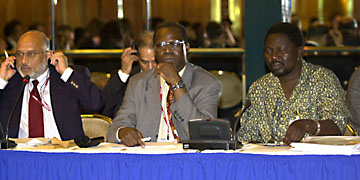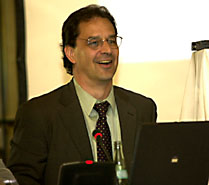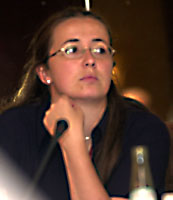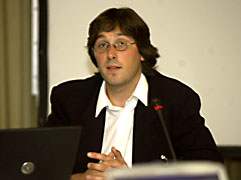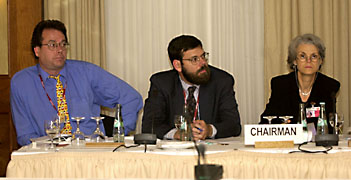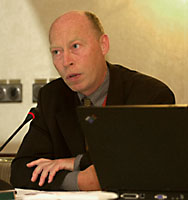|
|
|||||||||||||||||||||||||||||
|
|||||||||||||||||||||||||||||
|
Events convened on Thursday, 13 June |
|
Global Environment Facility briefing on National Adaptation Programmes
of Action and national focal point support for least developed countries
Presented by the Global Environment Facility (GEF)
Richard Hosier, UNDP, emphasized that countries should submit NAPA proposals through the implementing agency that provided assistance with its climate change enabling activities in order to minimize delay and inefficiency. In cases in which UNDP is the appropriate agency, the steps to be taken include: expression of intent from the UNFCCC focal point; compilation of a proposal in consultation with the UNDP regional coordinator; a letter of endorsement from the GEF and UNFCCC focal points; revision of comments received from UNDP headquarters; and submission of a final proposal to the GEF. Annie Roncerel, UNITAR, introduced UNITAR's project to provide information technology equipment and training to LDCs' UNFCCC focal points. She explained that the adoption of Memoranda of Agreement between LDCs and UNITAR are a prerequisite for the provision of US$13,000 grants, which are invested in local training and equipment procurement. She noted that thus far, 40 Memoranda of Agreement had been signed, 38 grants authorized, and 30 focal points equipped, connected and trained. Roncerel highlighted lessons learned from the project, including the feasibility of participating in global issues by acting locally through UNFCCC focal points, and the importance of time and flexibility.
|
|
How to address scale, leakage and permanence in land use, land-use change and forestry (LULUCF) projects Presented by The Nature Conservancy (TNC)
John Niles, University of California Berkeley, presented a study examining the scale of LULUCF in developing countries on the carbon market. The study concluded that: LULUCF from developing countries will modestly influence the market; the degree of influence depends on US participation, the types of projects, and the investment and political climate; without the US, the impact of LULUCF on the market will most likely be a political decision due to hot air and Annex Z allowances; combined demand, proportional mitigation and LULUCF would lower costs by 40%; and the impact of LULUCF will be highly dependent on actual project implementation success rates. He emphasized that LULUCF from developing countries will not swamp the carbon market, but will meet approximately 15% of the carbon offsets demanded. Louise Aukland, EcoSecurities, presented a study on carbon accounting and the temporary nature of carbon storage. She explained that the reversibility of emissions reductions requires special carbon accounting, and liabilities must be allocated and risk addressed. She outlined the results of three carbon accounting methods: stock change; average storage; and ton year. She highlighted the study's conclusion that stock change is the most environmentally conservative method, as it: does not account for temporary storage; assumes 100% liability for re-emissions; provides the most flexibility to project developers; allows the discontinuation of the project at any time, subject to the replacement of credits -- although the longer the storage period, the lower the present value of credit replacement; and time value provides an incentive for permanence. She stressed the need to define whether the replacement of credits should be on an ongoing basis or only at the end of a planned cycle; and whether replacement should be with certified emissions reductions (CERs) from emission reduction projects, other forestry projects, or a renovation of the existing contract.
|
|
The Kyoto Protocol and EU competitiveness: How much will EU industries suffer? Presented by the National Institute of Public Health and the Environment (RIVM)
Johannes Bollen, RIVM, outlined the findings of the study. He explained that the model employed in the study revealed that the impacts of the Kyoto Protocol on the output of energy-intensive sectors are modest at the EU aggregate level, with a decrease of 0.4% in 2010 with emissions trading, and a decrease of 0.6% without emissions trading. He noted that replacing current energy taxes with a carbon tax would lessen the Protocol's impacts on the output of the EU's energy-intensive sectors. Bollen explained that the Protocol would affect the competitiveness of energy-intensive sectors among EU member States, with Spain and the Netherlands suffering the largest decrease in output due to their higher energy intensity. He noted that leakage would amount to 17%, but could rise to 21% if emissions trading fails, or fall to 13% with tax reform. John Drexhage, International Institute for Sustainable Development (IISD), welcomed the study, as Canada is currently undergoing an intensive national consultation process on Kyoto Protocol implementation. He highlighted the value of expressing the losses incurred from Protocol implementation in absolute dollar terms as well as a percentage of GDP. He highlighted the significant reductions in emissions from the business as usual forecast required for Canada relative to the EU, and the particular difficulties Canada faces related to competitiveness given its proximity and trade relations with the US, and recommended that the study disaggregate Canada from Japan, New Zealand and others in light of this situation. Drexhage noted that there is no interest in buying hot air in Canada, which may have an impact on the overall price of carbon. He also highlighted the utility of examining the specific impacts of the Protocol on the oil, gas and coal sectors.
Marianne Wenning, European Commission, agreed that the model is useful. She noted, however, that it assumes only international trading but no internal EU trading, looks only at carbon dioxide rather than at all GHGs, has a relatively short time horizon, and fails to consider policies not subject to trading, all of which could affect the overall cost of the Protocol to the EU. She also noted that employment benefits likely to emerge in new sectors could outweigh employment losses in energy-intensive sectors.
|
|
Standardizing procedures for Joint Implementation and Clean Development Mechanism baselines and accounting Presented by the Foundation Joint Implementation Network (JIN)
Catrinus Jepma, JIN,
introduced the "Procedures for Accounting and Baselines for Projects
under Joint Implementation and the Clean Development Mechanism" (PROBASE)
project, which aims to: develop operational procedures for Joint
Implementation (JI) and the Clean Development Mechanism (CDM) that are
compatible with the Marrakesh accords; explore ways of standardizing
baselines and procedures; systematically codify existing baseline
knowledge and experience; and design an electronic GHG accounting manual
for project developers and validators. He emphasized that standardizing
baselines and procedures will promote the implementation and integrity
of JI and CDM projects and reduce their transaction costs.
Kazuhito Yamada, JIN, introduced an interim report on technical procedures for planning CDM and JI projects, compiled by the Working Group on Baselines for CDM and JI Projects established by the Japanese Ministry of the Environment. He outlined steps in a project's planning phase, including: establishing a project's impacts; estimating its GHG emissions reduction and enhancement of removal; and designing a monitoring plan. Yamada stated that estimating a project's impacts involves defining direct and indirect impacts, identifying impacts caused by GHG emissions and enhancement of removal, and determining project boundaries. He explained how several flowcharts can be used to assess a project's impacts and estimate its GHG emissions reduction and enhancement of removal.
|
|
|
|
| The Earth Negotiations Bulletin (ENB) on the side is a special publication of the International Institute for Sustainable Development (IISD) in cooperation with the United Nations Framework Convention on Climate Change (UNFCCC) Secretariat. This issue has been written by Dagmar Lohan dagmar@iisd.org and Kira Schmidt kira@iisd.org. The Digital Editors are David Fernau david@iisd.org, Andrei Henry andrei@iisd.org, Leila Mead leila@iisd.org and Diego Noguera diego@iisd.org. Funding for publication of ENB on the side at UNFCCC SB-16 is provided by the UNFCCC Secretariat. The opinions expressed in ENB on the side are those of the authors and do not necessarily reflect the views of IISD and funders. Excerpts from ENB on the side may be used in non-commercial publications only and only with appropriate academic citation. For permission to use this material in commercial publications, contact the Managing Editor at kimo@iisd.org. Electronic versions of issues of ENB on the side from UNFCCC SB-16 can be found on the Linkages website at http://enb.iisd.org/climate/sb16/enbots/. | |
|
|
| © 2002, IISD. All rights reserved. |
|



